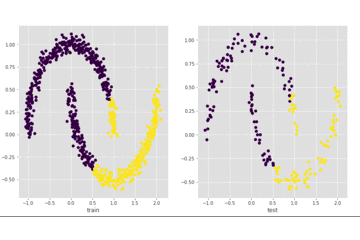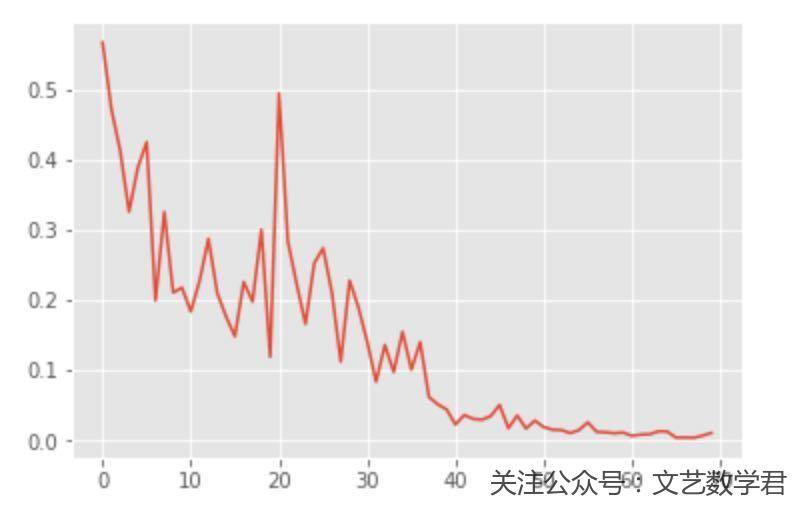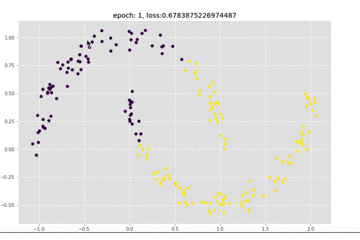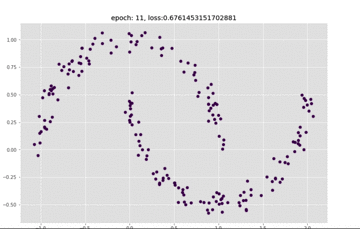文章目录(Table of Contents)
前言
上一篇文章讲了三种框架来实现线性回归,TensorFlow,Keras,PyTorch框架了解–实现线性回归,这一篇文章会详细介绍一下PyTorch的使用,会使用一个分类的例子来进行介绍。
马上就要是文艺数学君一周年的周年纪念了,到时候看看会有些什么。希望文艺数学君越做越好。
下面就开始正式讲关于PyTorch的内容,我们这次来讲一下分类,上次讲了线性回归,我们的神经网络还是就使用全连接层和激活层来搭建。
这一次介绍的四个模型分别是会比较两种激活函数,ReLU和Sigmoid,模型二和模型三;同时会比较不同层数的区别,模型一与模型二;同时会看一种数据增维的方法,模型四。下面就开始来讲吧。
实现分类
数据准备
我们首先使用sklearn中的datasets生成我们需要的数据;
- import numpy as np
- from sklearn import datasets
- from matplotlib import pyplot as plt
- # 生成样例数据
- noisy_moons, labels = datasets.make_moons(n_samples=1000, noise=.05, random_state=10) # 生成 1000 个样本并添加噪声
- # 其中800个作为训练数据,200个作为测试数据
- X_train,Y_train,X_test,Y_test = noisy_moons[:-200],labels[:-200],noisy_moons[-200:],labels[-200:]
- print(len(X_train),len(Y_train),len(X_test),len(Y_test))
- >> 800 800 200 200
我们可以画图看一下数据的样子:
- plt.figure(figsize=(8,6))
- plt.scatter(X_test[:,0],X_test[:,1],c=Y_test)

从上面的图像可以看到,我们的数据呈现月牙的形状,这种形状的数据直接使用k-means聚类是不能区分的,下面我们来搭建神经网络来实现以下数据的分类;
我们首先把要使用到的库进行导入:
- import torch as t
- from torch import nn
- from torch import optim
- from torch.autograd import Variable
- import torch.utils.data as Data
- from IPython import display
网络一(使用ReLU作为激活函数、三层)
下面开始介绍第一个模型,由于后面每个模型的代码内容基本差不多,即定义优化器,损失函数,训练绘图那里,就网络定义的地方有点区别,我们就着重先讲网络的结构,后面就贴一下全部的代码:
- # ---------
- # 网络的定义
- # ---------
- class classifer(nn.Module):
- def __init__(self):
- super(classifer, self).__init__()
- self.class_col = nn.Sequential(
- nn.Linear(2,16),
- nn.ReLU(),
- nn.Linear(16,16),
- nn.ReLU(),
- nn.Linear(16,2),
- )
- def forward(self, x):
- out = self.class_col(x)
- return out
上面是我们这里使用的网络的结构,输入是2是因为数据有x和y,最后输出也是2是因为分为两类,整个网络一共有三层,下面贴一下完整的代码,注释已经写得很详细了,可以复制下来仔细看一下;
- # ----------
- # 生成样例数据
- # ----------
- noisy_moons, labels = datasets.make_moons(n_samples=1000, noise=.05, random_state=10) # 生成 1000 个样本并添加噪声
- # 其中800个作为训练数据,200个作为测试数据
- X_train,Y_train,X_test,Y_test = noisy_moons[:-200],labels[:-200],noisy_moons[-200:],labels[-200:]
- # print(len(X_train),len(Y_train),len(X_test),len(Y_test))
- # ---------
- # 网络的定义
- # ---------
- class classifer(nn.Module):
- def __init__(self):
- super(classifer, self).__init__()
- self.class_col = nn.Sequential(
- nn.Linear(2,16),
- nn.ReLU(),
- nn.Linear(16,16),
- nn.ReLU(),
- nn.Linear(16,2),
- )
- def forward(self, x):
- out = self.class_col(x)
- return out
- # ----------------
- # 定义优化器及损失函数
- # ----------------
- from torch import optim
- model = classifer() # 实例化模型
- loss_fn = nn.CrossEntropyLoss() # 定义损失函数
- optimiser = optim.SGD(params=model.parameters(), lr=0.05) # 定义优化器
- # ------
- # 定义变量
- # ------
- from torch.autograd import Variable
- import torch.utils.data as Data
- X_train = t.Tensor(X_train) # 输入 x 张量
- X_test = t.Tensor(X_test)
- Y_train = t.Tensor(Y_train).long() # 输入 y 张量
- Y_test = t.Tensor(Y_test).long()
- # 使用batch训练
- torch_dataset = Data.TensorDataset(X_train, Y_train) # 合并训练数据和目标数据
- MINIBATCH_SIZE = 25
- loader = Data.DataLoader(
- dataset=torch_dataset,
- batch_size=MINIBATCH_SIZE,
- shuffle=True,
- num_workers=2 # set multi-work num read data
- )
- # ---------
- # 进行训练
- # ---------
- loss_list = []
- plt.style.use('ggplot')
- for epoch in range(70):
- for step, (batch_x, batch_y) in enumerate(loader):
- optimiser.zero_grad() # 梯度清零
- out = model(batch_x) # 前向传播
- loss = loss_fn(out, batch_y) # 计算损失
- loss.backward() # 反向传播
- optimiser.step() # 随机梯度下降
- loss_list.append(loss)
- if epoch%10==0:
- outputs_train = model(X_train)
- _, predicted_train = t.max(outputs_train, 1)
- outputs_test = model(X_test)
- _, predicted_test = t.max(outputs_test, 1)
- # 同时画出训练集和测试的效果
- display.clear_output(wait=True)
- fig, axes = plt.subplots(nrows=1, ncols=2, figsize=(13,7))
- axes[0].scatter(X_train[:,0].numpy(),X_train[:,1].numpy(),c=predicted_train)
- axes[0].set_xlabel('train')
- axes[1].scatter(X_test[:,0].numpy(),X_test[:,1].numpy(),c=predicted_test)
- axes[1].set_xlabel('test')
- display.display(fig)
我们来看一下上面代码的输出,左边是训练集上的结果,右边是测试集上的结果:

可以看到最终可以全部分开,我们再看一下loss的情况:

网络二(使用ReLU作为激活函数、五层)
这个网络和上面的区别在于网络层数变深了,我们看一下这时候的情况,还是先看一下网络的定义:
- class classifer(nn.Module):
- def __init__(self):
- super(classifer, self).__init__()
- self.class_col = nn.Sequential(
- nn.Linear(2,16),
- nn.ReLU(),
- nn.Linear(16,32),
- nn.ReLU(),
- nn.Linear(32,32),
- nn.ReLU(),
- nn.Linear(32,32),
- nn.ReLU(),
- nn.Linear(32,2),
- )
- def forward(self, x):
- out = self.class_col(x)
- return out
和上面的差不多,就是变深了,看一下完整的代码:
- # 网路变深
- # ----------
- # 生成样例数据
- # ----------
- noisy_moons, labels = datasets.make_moons(n_samples=1000, noise=.05, random_state=10) # 生成 1000 个样本并添加噪声
- # 其中800个作为训练数据,200个作为测试数据
- X_train,Y_train,X_test,Y_test = noisy_moons[:-200],labels[:-200],noisy_moons[-200:],labels[-200:]
- # print(len(X_train),len(Y_train),len(X_test),len(Y_test))
- # ---------
- # 网络的定义
- # ---------
- class classifer(nn.Module):
- def __init__(self):
- super(classifer, self).__init__()
- self.class_col = nn.Sequential(
- nn.Linear(2,16),
- nn.ReLU(),
- nn.Linear(16,32),
- nn.ReLU(),
- nn.Linear(32,32),
- nn.ReLU(),
- nn.Linear(32,32),
- nn.ReLU(),
- nn.Linear(32,2),
- )
- def forward(self, x):
- out = self.class_col(x)
- return out
- # ----------------
- # 定义优化器及损失函数
- # ----------------
- from torch import optim
- model = classifer() # 实例化模型
- loss_fn = nn.CrossEntropyLoss() # 定义损失函数
- optimiser = optim.SGD(params=model.parameters(), lr=0.05) # 定义优化器
- # ------
- # 定义变量
- # ------
- from torch.autograd import Variable
- import torch.utils.data as Data
- X_train = t.Tensor(X_train) # 输入 x 张量
- X_test = t.Tensor(X_test)
- Y_train = t.Tensor(Y_train).long() # 输入 y 张量
- Y_test = t.Tensor(Y_test).long()
- # 使用batch训练
- torch_dataset = Data.TensorDataset(X_train, Y_train) # 合并训练数据和目标数据
- MINIBATCH_SIZE = 25
- loader = Data.DataLoader(
- dataset=torch_dataset,
- batch_size=MINIBATCH_SIZE,
- shuffle=True,
- num_workers=2 # set multi-work num read data
- )
- # ---------
- # 进行训练
- # ---------
- loss_list = []
- for epoch in range(200):
- for step, (batch_x, batch_y) in enumerate(loader):
- optimiser.zero_grad() # 梯度清零
- out = model(batch_x) # 前向传播
- loss = loss_fn(out, batch_y) # 计算损失
- loss.backward() # 反向传播
- optimiser.step() # 随机梯度下降
- loss_list.append(loss)
- if epoch%10==0:
- outputs = model(X_test)
- _, predicted = t.max(outputs, 1)
- display.clear_output(wait=True)
- plt.style.use('ggplot')
- plt.figure(figsize=(12, 8))
- plt.scatter(X_test[:,0].numpy(),X_test[:,1].numpy(),c=predicted)
- plt.title("epoch: {}, loss:{}".format(epoch+1, loss))
- plt.show()
还是看一下训练过程中结果的变化,可以看到收敛还是很快的

接下来可以看一下loss的变化情况,和上面的模型比起来,loss下降更加快了。

网络三(使用Sigmoid作为激活函数、五层)
这个网络我们使用Sigmoid作为激活函数来尝试一下,其他的不变。我们还是先把网络结构打印出来:
- # ---------
- # 网络的定义
- # ---------
- class classifer(nn.Module):
- def __init__(self):
- super(classifer, self).__init__()
- self.class_col = nn.Sequential(
- nn.Linear(2,16),
- nn.Sigmoid(),
- nn.Linear(16,32),
- nn.Sigmoid(),
- nn.Linear(32,32),
- nn.Sigmoid(),
- nn.Linear(32,32),
- nn.Sigmoid(),
- nn.Linear(32,2),
- )
- def forward(self, x):
- out = self.class_col(x)
- return out
接下来看一下完整的代码:
- # 调节网络获得更好的结果
- # ----------
- # 生成样例数据
- # ----------
- noisy_moons, labels = datasets.make_moons(n_samples=1000, noise=.05, random_state=10) # 生成 1000 个样本并添加噪声
- # 其中800个作为训练数据,200个作为测试数据
- X_train,Y_train,X_test,Y_test = noisy_moons[:-200],labels[:-200],noisy_moons[-200:],labels[-200:]
- # print(len(X_train),len(Y_train),len(X_test),len(Y_test))
- # ---------
- # 网络的定义
- # ---------
- class classifer(nn.Module):
- def __init__(self):
- super(classifer, self).__init__()
- self.class_col = nn.Sequential(
- nn.Linear(2,16),
- nn.Sigmoid(),
- nn.Linear(16,32),
- nn.Sigmoid(),
- nn.Linear(32,32),
- nn.Sigmoid(),
- nn.Linear(32,32),
- nn.Sigmoid(),
- nn.Linear(32,2),
- )
- def forward(self, x):
- out = self.class_col(x)
- return out
- # ----------------
- # 定义优化器及损失函数
- # ----------------
- from torch import optim
- model = classifer() # 实例化模型
- loss_fn = nn.CrossEntropyLoss() # 定义损失函数
- optimiser = optim.SGD(params=model.parameters(), lr=0.1) # 定义优化器
- # ------
- # 定义变量
- # ------
- from torch.autograd import Variable
- import torch.utils.data as Data
- X_train = t.Tensor(X_train) # 输入 x 张量
- X_test = t.Tensor(X_test)
- Y_train = t.Tensor(Y_train).long() # 输入 y 张量
- Y_test = t.Tensor(Y_test).long()
- # 使用batch训练
- torch_dataset = Data.TensorDataset(X_train, Y_train) # 合并训练数据和目标数据
- MINIBATCH_SIZE = 25
- loader = Data.DataLoader(
- dataset=torch_dataset,
- batch_size=MINIBATCH_SIZE,
- shuffle=True,
- num_workers=2 # set multi-work num read data
- )
- # ---------
- # 进行训练
- # ---------
- loss_list = []
- for epoch in range(500):
- for step, (batch_x, batch_y) in enumerate(loader):
- optimiser.zero_grad() # 梯度清零
- out = model(batch_x) # 前向传播
- loss = loss_fn(out, batch_y) # 计算损失
- loss.backward() # 反向传播
- optimiser.step() # 随机梯度下降
- loss_list.append(loss)
- if epoch%10==0:
- outputs = model(X_test)
- _, predicted = t.max(outputs, 1)
- display.clear_output(wait=True)
- plt.style.use('ggplot')
- plt.figure(figsize=(12, 8))
- plt.scatter(X_test[:,0].numpy(),X_test[:,1].numpy(),c=predicted)
- plt.title("epoch: {}, loss:{}".format(epoch+1, loss))
- plt.show()
看一下这个训练的动图,可以看到epoch是一直在变化的,前面模型收敛的比较慢:

下面我们看一下loss的图,来看一下上面的想法是否正确:

可以看到使用Sigmoid作为激活函数确实会收敛的慢一些,但是也不是所有的都适合用ReLU,有很多情况我也不确定,具体用的时候可以看一下别人写的论文之类的。
网络四(使用Sigmoid作为激活函数、五层、扩充数据集)
这个模型我们会重点介绍一下数据集扩展的方式,我们之前使用的数据集只有两个维度,可以认为是x1和x2,但是有的时候只有这两个数据是不够的,我们可以通过扩充数据集的方式使得模型更快的收敛:
- import math
- noisy_moons, labels = datasets.make_moons(n_samples=1000, noise=.05, random_state=10) # 生成 1000 个样本并添加噪声
- # 增加特征
- features1 = (noisy_moons[:,0] * noisy_moons[:,0]).reshape(-1,1)
- features2 = (noisy_moons[:,1] * noisy_moons[:,1]).reshape(-1,1)
- features3 = (noisy_moons[:,0] * noisy_moons[:,1]).reshape(-1,1)
- features4 = np.array([math.sin(i) for i in noisy_moons[:,0]]).reshape(-1,1)
- features5 = np.array([math.sin(i) for i in noisy_moons[:,1]]).reshape(-1,1)
- noisy_moons = np.hstack((noisy_moons,features1,features2,features3,features4,features5))
可以看到上面的代码,我们增加了五个特征,x1^2, x2^2, x1*x2, sin(x1)和sin(x1) ,其余的我们不变,还是使用上面的网络结构进行训练,只不过输入要改成7。
我们来看一下上面数据合并的方法,使用一个简单的例子进行查看:

接下来我们来看一下代码:
- # 增加特征获得更好的结果
- import math
- # ----------
- # 生成样例数据
- # ----------
- noisy_moons, labels = datasets.make_moons(n_samples=1000, noise=.05, random_state=10) # 生成 1000 个样本并添加噪声
- # 增加特征
- features1 = (noisy_moons[:,0] * noisy_moons[:,0]).reshape(-1,1)
- features2 = (noisy_moons[:,1] * noisy_moons[:,1]).reshape(-1,1)
- features3 = (noisy_moons[:,0] * noisy_moons[:,1]).reshape(-1,1)
- features4 = np.array([math.sin(i) for i in noisy_moons[:,0]]).reshape(-1,1)
- features5 = np.array([math.sin(i) for i in noisy_moons[:,1]]).reshape(-1,1)
- noisy_moons = np.hstack((noisy_moons,features1,features2,features3,features4,features5))
- # 其中800个作为训练数据,200个作为测试数据
- X_train,Y_train,X_test,Y_test = noisy_moons[:-200],labels[:-200],noisy_moons[-200:],labels[-200:]
- # print(len(X_train),len(Y_train),len(X_test),len(Y_test))
- # ---------
- # 网络的定义
- # ---------
- class classifer(nn.Module):
- def __init__(self):
- super(classifer, self).__init__()
- self.class_col = nn.Sequential(
- nn.Linear(7,32),
- nn.Sigmoid(),
- nn.Linear(32,32),
- nn.Sigmoid(),
- nn.Linear(32,32),
- nn.Sigmoid(),
- nn.Linear(32,32),
- nn.Sigmoid(),
- nn.Linear(32,2),
- )
- def forward(self, x):
- out = self.class_col(x)
- return out
- # ----------------
- # 定义优化器及损失函数
- # ----------------
- from torch import optim
- model = classifer() # 实例化模型
- loss_fn = nn.CrossEntropyLoss() # 定义损失函数
- optimiser = optim.SGD(params=model.parameters(), lr=0.1) # 定义优化器
- # ------
- # 定义变量
- # ------
- from torch.autograd import Variable
- import torch.utils.data as Data
- X_train = t.Tensor(X_train) # 输入 x 张量
- X_test = t.Tensor(X_test)
- Y_train = t.Tensor(Y_train).long() # 输入 y 张量
- Y_test = t.Tensor(Y_test).long()
- # 使用batch训练
- torch_dataset = Data.TensorDataset(X_train, Y_train) # 合并训练数据和目标数据
- MINIBATCH_SIZE = 25
- loader = Data.DataLoader(
- dataset=torch_dataset,
- batch_size=MINIBATCH_SIZE,
- shuffle=True,
- num_workers=2 # set multi-work num read data
- )
- # ---------
- # 进行训练
- # ---------
- loss_list = []
- for epoch in range(500):
- for step, (batch_x, batch_y) in enumerate(loader):
- optimiser.zero_grad() # 梯度清零
- out = model(batch_x) # 前向传播
- loss = loss_fn(out, batch_y) # 计算损失
- loss.backward() # 反向传播
- optimiser.step() # 随机梯度下降
- loss_list.append(loss)
- if epoch%10==0:
- outputs = model(X_test)
- _, predicted = t.max(outputs, 1)
- display.clear_output(wait=True)
- plt.style.use('ggplot')
- plt.figure(figsize=(12, 8))
- plt.scatter(X_test[:,0].numpy(),X_test[:,1].numpy(),c=predicted)
- plt.title("epoch: {}, loss:{}".format(epoch+1, loss))
- plt.show()
我们就直接看一下loss变化趋势的图像,可以看到这次的收敛会比上面做数据扩展之前快一些。

结语
关于上面四个模型的比较,我们可以看到当模型层数较深,且使用ReLU作为激活函数时效果会比较好,同时我们还学习了一种数据增维的方式。
这次的关于PyTorch的介绍到这里为止,其实内容也不是很多,很多代码片段都是重复的,我就只是多写了几次,方便之后直接复制来进行运行。
之后的话会继续更新关于深度学习的内容(写一篇文章挺久的,慢慢写)。
- 微信公众号
- 关注微信公众号
-

- QQ群
- 我们的QQ群号
-













2019年2月13日 下午7:12 1F
写的非常好,对我帮我很大
2019年2月13日 下午10:53 B1
@ 马掌头 谢谢支持呀